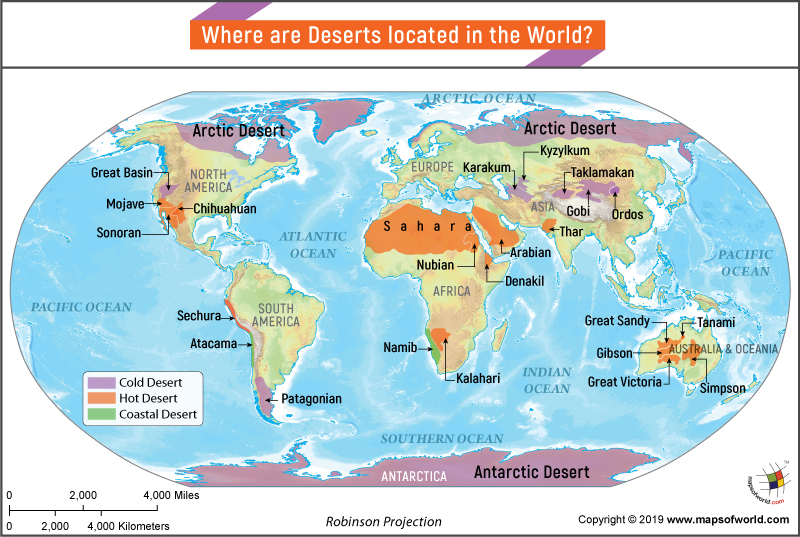Where are Deserts Located

Deserts are defined as barren areas that receive less than 250 mm (10 inches) of annual precipitation. Deserts have extreme climatic conditions either hot or cold. They can be found anywhere in the world where there is little water. In this article, we will further explore where are deserts located, factors affecting location of deserts, where are the largest and smallest deserts located and more.
Locations of Deserts
Deserts can be found all over the world from tropical regions to the backside of the mountains on every continent. They cover more than one-fifth of the Earth’s land area. They are often found on the western edge of the continent due to the cold ocean currents which run along the coast. The cold ocean currents make it harder to hold moisture. Most of the desert regions of the earth are undergoing periods of climate change. The regions that are deserts today were not always very dry.
Factors Affecting the Location of Deserts
The major factors which affect the location of deserts around the world are:
- Latitude: The desert areas are mostly found between 15 and 30 degrees north or south of the equator. This region receives direct sunlight throughout the year, and the intense heat causes the air to rise, losing its moisture before it can condense and fall as rain.
- Ocean currents: Coastal deserts are created due to cold ocean currents flowing along the western coasts of continents.
- Rain shadow effect: When mountains lie in the path of moisture-laden winds, the air cools, condenses and releases its moisture as rain or snow on the windward side of the mountains. Thus on the leeward side of mountains, the air is dry and warm creating a rain shadow desert.
- Continental Location: The desert areas can form in the interior of continents, far away from large bodies of water. The areas tend to be dry as there is no nearby source of moisture.
Where is World’s Largest Desert
The largest desert in the world is the Antarctic Desert located in the Southern Hemisphere in the continent of Antarctica. The desert covers an area of 14.2 million square kilometers (5.5 million square miles). The ice that covers the cold desert is on average 2.45 kilometers (1.5 miles) thick. The Antarctic desert is the coldest desert on the Earth with almost no vegetation and the animals are mostly carnivores such as penguins, albatrosses, seals and whales.
Where is World’s Smallest Desert
The smallest desert globally, Carcross Desert, is situated in Yukon region of Canada. Covering an area of about 1 square mile or 640 acres, this tiny desert stands out not only due to its size but also for its striking contrast against the lush greenery that surrounds it.
Major Deserts in the World and Their Locations
Berkeley’s Biomes group divides the major deserts of the world into four main categories based on where they are located geographically.
-
Hot Deserts
Most of these deserts are located close to the Tropic of Cancer and Capricorn, between 15 and 30 degrees north or south of the equator. The temperature in these deserts remains warm and dry all year round.
Major Hot Deserts and Their Locations
- Sahara Desert (Africa) – It is the world’s largest hot desert, covering vast regions of North Africa.
- Arabian Desert (Middle East) – It stretches across the Arabian Peninsula. It is one of the largest continuous deserts.
- Sonoran Desert (North America) – Found in the southwestern United States and Mexico, the Sonoran Desert is well-known for its rich variety of plant and animal life.
- Thar Desert (Asia) –Located in northwestern India and southeastern Pakistan, the Thar Desert is famous for its vast stretches of sandy dunes and challenging weather conditions.
-
Semiarid Deserts
Comparatively cooler than hot deserts, semi-arid deserts experience long and dry summers followed by winters with some light rain. These deserts are located in North America, Greenland, Europe, and Asia.
Major Semiarid Deserts and Their Locations
- Great Basin Desert (North America) – Spanning across Nevada, Utah, and portions of Oregon, Idaho, and Wyoming, the Great Basin Desert holds the title of the largest semiarid desert in the United States.
- Gobi Desert (Asia) – This desert, famous for its special scenery with sandy hills and rocky plateaus, is located in northern China and southern Mongolia.
- Patagonian Desert (South America) – It is located in southern Argentina and Chile. It experiences cool and windy conditions, with precipitation concentrated in the winter months.
-
Coastal Deserts
These types of deserts are comparatively more humid than other types of deserts. The summers are moderately warm and long followed by cool winters. Heavy fogs blow in from the coast in these types of deserts but rainfall is rare.
Major Coastal Deserts and Their Locations
- Atacama Desert (South America) – Stretching along the western coast of Chile, the Atacama Desert holds renown as one of the driest places on Earth.
- Namib Desert (Africa) – The Namib Desert, situated along the Atlantic coast of Namibia, earns renown for its towering red sand dunes.
- Peruvian Desert (South America) – Spanning the northern coastal region of Peru, this desert exhibits arid conditions with little rainfall.
-
Cold Deserts
Regions with cold winters and snowfall characterize these desert areas. These regions experience short, moist, and moderately warm winters along with fairly long, cold winters. Cold deserts exist in the Antarctic (South Pole), Greenland, and parts of North America.
Major Cold Deserts and Their Locations
- Antarctic Desert (Antarctica) – It covers the continent of Antarctica. The Antarctic Desert is the largest cold desert on Earth.
- Greenland Desert (Greenland) – Greenland is the world’s largest island and hosts a cold desert environment.
Related Maps
